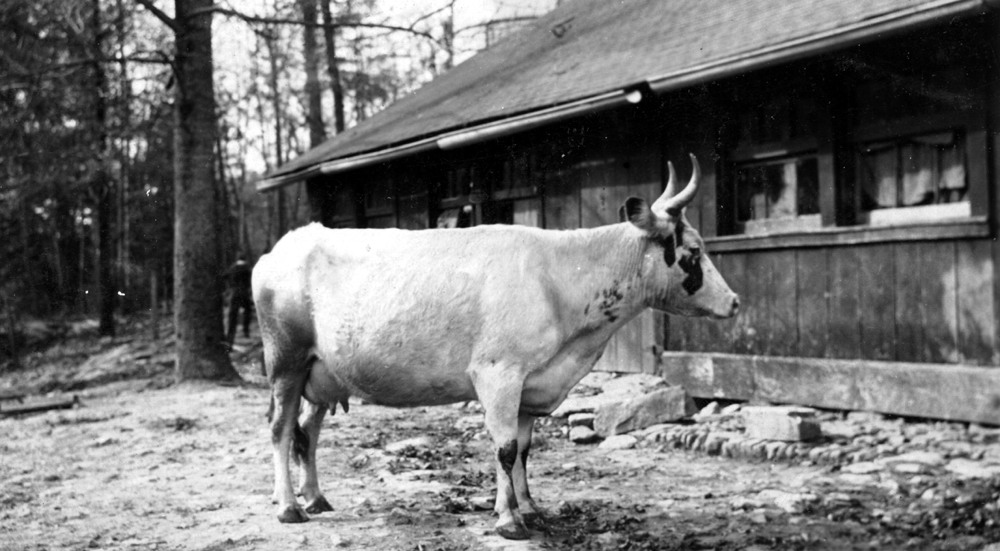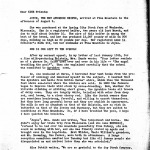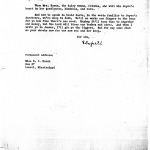Pine Mountain Settlement School
Series 02: GOVERNANCE – Board of Trustees
Series 11: FARM
Elizabeth Hench, Trustee, 1914-1931(?)
Elizabeth C. Hench (1869–1939)
Joy Stock Company Limited Letter 1927

Barn. Ayrshire cow. [II_7_barn_285.jpg]
TAGS: Elizabeth Hench, fundraising letters, Joyce (Cavalier’s Ruth III), Ayrshires, Spring City Stock farm, Ethel de Long Zande, Dr. Osler, Holsteins, Bobbie Burns’ shire, cow research, cross-breeding, dairy cows, Scots, Jerseys, Guernseys, Brit Wilder, William Browning, Joy Stock Company Limited, Martha Burns
ELIZABETH HENCH Joy Stock Company Limited Letter 1927
TRANSCRIPTION
[page 1]
September, 1927
Dear KINE friends:
JOYCE, THE NEW AYRSHIRE HEIFER, arrived at Pine Mountain in the afternoon of August 9.
She was purchased at the Spring City Stock farm of Waukesha, Wisconsin. She is a registered heifer, two years old last March, and due to calf about October 10. The sire of this heifer is among the best of the breed, and her dam produced 12, 007 pounds of milk in 300 days, milking as high as 82 pounds per day. Her registered name is Cavalier’s Ruth III, but her nickname at Pine Mountain is Joyce.
SHE IS OUR GIFT TO THE SCHOOL!
After my earnest appeal, in my letter of last January 13th, for a fine milk-producing Holstein, Mrs. Zande wrote: “Your letter reminds me of a phrase Dr. Osler used over and over in his life — ‘The angel troubling the pool.'” Then she explained carefully that the school was committed to Ayrshire cows.
So, one week-end at Berea, I borrowed four text books from the professor of cowology and immersed myself in the subject. I learned that the Ayrshire cow hails from Bobbie Burns’ shire, which lies two thousand feet above sea-level where the winters are cold. In 1800 the farmers began to improve their wild stock by cross-breeding. Now, whether for hillside climbing or nibbling short grass, the Ayrshire leads all breeds of dairy cows. They are largely white, brindled with color from deep red, seal brown, to a clear cherry red. Like the Scotch owners they are sometimes headstrong, forceful, and willing to assert themselves. But they have long graceful horns and they are stylish in appearance. The milk is not as abundant as that of the Holstein, nor as rich in butterfat as that of the Jersey and Guernsey, but they are suited to conditions at Pine Mountain. So, if I have troubled the pool, I hope I have quieted the wavelets.
“Joyce”, Mrs. Zande writes, “has temperament and horns. She didn’t enjoy her train trip from Wisconsin (and she came EXPRESS) refused to be led over the mountain peacefully from Putney, six men could do nothing with her, and she was finally crated up again and brought over in the log-train. Bret (sic) Wilder, Uncle William’s grandson, and Mr. Browning, the farmer, were both in attendance. A large reception committee awaited her Tuesday but like all famous people she disappointed us and arrived later than she was scheduled.”
Miss Pettit writes, “We are so grateful to the Joy Stock Company…
[page 2]
…Limited, for her. I have always wanted you to know how thankful I am for the intelligent interest of all of you in this most important department.”
When Mrs. Burns, the dairy woman, returns, she will win Joyce’s heart by her gentleness, kindness, and care.
And now to speak in braid [broad] Scots, the words familiar to Joyce’s forebears, we’re deep in debt. We’ll no work our fingers to the bone fo[?] ye ken fine there’s nae need. Mayhap it’ll taen[?] time to ingather our money, but the Lord will bless our basket and store. And when I write ye in Janwar, I’ll gie ye the figgers. But for any sake sind me your checks now for our new cou [cow] and her keep.
Yer ain [own],
[signed] Elspeth [Scottish for Elizabeth]
Permanent address:
Miss E. C. Hench
Box 67
Laurel, Mississippi
GALLERY: Joy Stock Company Limited Letter 1927
- Cow Letter, Sept 1927, p.1. [hench_0001.jpg]
- Cow Letter, Sept 1927, p.2. [hench_0002.jpg]
Return To:
ELIZABETH HENCH GUIDE Joy Stock Company Limited Letters 1927-1933
See Also:
ELIZABETH HENCH Trustee



